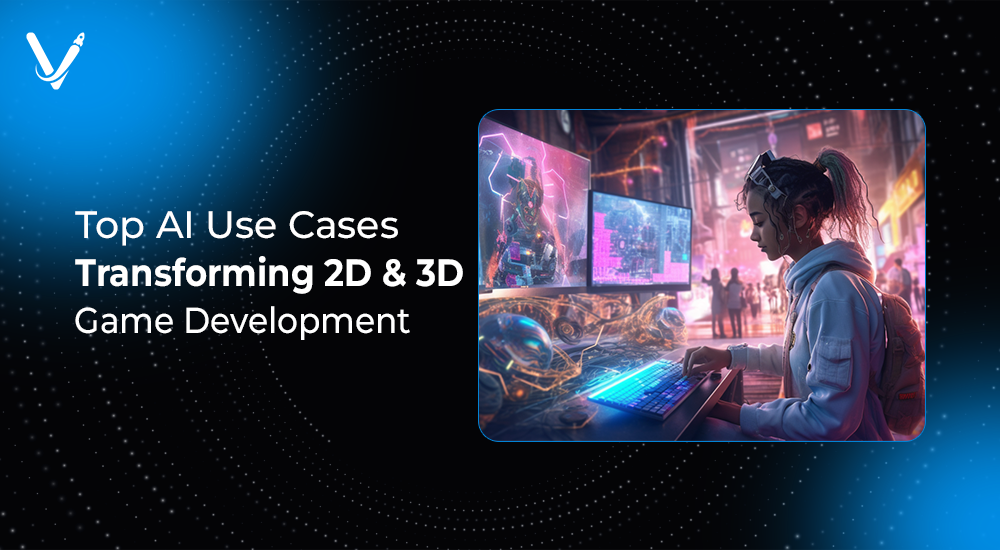Top AI Use Cases Transforming 2D & 3D Game Development


- Aug 22, 2025



Game development has always been about blending creativity with technology. In the early days, developers relied on hand-coded logic and manual art creation to bring games to life. Today, the landscape is shifting at an unprecedented pace as artificial intelligence (AI) becomes a core driver of innovation. AI is no longer a sidekick in development—it has become a co-creator, enabling studios to build more immersive, realistic, and personalized gaming experiences.
For 2D and 3D games alike, AI is redefining how characters behave, how environments evolve, and how players interact with virtual worlds. From intelligent NPCs and procedural content generation to AI-assisted art pipelines and real-time personalization, developers are leveraging AI to accelerate production, reduce costs, and deliver experiences that feel alive.
This article explores the top AI use cases transforming both 2D and 3D game development. It dives into real-world applications, explains the technology behind them, and highlights how game studios—large and small—are using AI to create engaging worlds that captivate players.
Before diving into specific use cases, it’s important to understand why AI has become such a game-changer in development. Game creation has always been resource-heavy, requiring vast teams of artists, programmers, and testers. AI brings automation and intelligence into this workflow, freeing developers to focus more on creativity than manual repetition.
AI has found its way into virtually every corner of the gaming pipeline. In design, it speeds up asset creation and testing. In development, it provides adaptive algorithms that simulate human-like decision-making. In gameplay, it personalizes player experiences and drives replayability. By bridging the gap between creativity and efficiency, AI offers developers the ability to do more with fewer resources while still pushing the boundaries of innovation.
2D and 3D games have different demands, but AI adapts to both. While 2D games lean heavily on narrative and stylized visuals, 3D games require realism, physics, and complex environments. AI steps in to address these unique challenges, providing artists and developers with tools tailored for each type of experience.
2D games may look simpler than 3D titles, but they often require intense manual work, especially when it comes to art and animation. AI helps small and large teams alike by automating repetitive tasks and generating high-quality visual and narrative assets quickly.
In 2D games, visual assets define much of the charm and immersion. Traditionally, artists had to painstakingly design each sprite and frame of animation. Today, AI tools trained on vast libraries of art styles can automatically generate character sprites, environmental backgrounds, and even frame-by-frame animations. Developers can input text prompts or rough sketches, and AI fills in the details, allowing artists to focus on refinement rather than repetitive tasks.
Smooth animation is critical for 2D games, but hand-drawing every transition frame is labor-intensive. AI-powered motion interpolation tools can automatically generate in-between frames, making character and object movements more fluid. This accelerates production pipelines and ensures higher-quality animations even with small teams.
Replayability is the backbone of many 2D games, especially roguelikes and puzzle platformers. AI enhances procedural generation by analyzing player behavior and creating levels that balance challenge with accessibility. Instead of randomness, AI creates intentional variety that feels handcrafted yet endlessly fresh.
Narrative-driven 2D games rely heavily on engaging dialogue. AI models can dynamically write conversations and branching storylines that adapt to player choices. This reduces repetitiveness and gives players a more natural and emotionally engaging experience.
3D game development is often seen as the pinnacle of complexity in the gaming industry. Building lifelike environments, believable NPCs, and realistic animations requires huge resources. AI eases this burden by generating assets, simulating behaviors, and automating rendering tasks that once required entire teams.
NPCs are the lifeblood of immersive 3D games. AI-powered NPCs can now think and adapt on their own, responding to player actions in ways that mimic human decision-making. This makes encounters less predictable and vastly improves realism in gameplay.
Modeling and texturing are two of the most time-intensive aspects of 3D game development. AI tools now generate textures, meshes, and even entire environments from simple inputs. This allows developers to quickly populate massive worlds without sacrificing visual fidelity.
Open-world games are larger than ever, but AI procedural generation ensures they remain dynamic and engaging. By learning from player actions, AI can build evolving landscapes, hidden areas, and unique encounters that make every playthrough feel distinct.
Instead of relying solely on motion capture, AI-driven physics and animation models simulate lifelike movements automatically. Characters can adapt their posture to terrain, weather conditions, or combat scenarios, enhancing immersion without adding significant costs.
Rendering lifelike 3D visuals used to demand immense computing power. With AI techniques like DLSS and neural rendering, games now achieve higher visual quality with optimized performance. This allows studios to deliver cinematic-quality graphics even on mid-range devices.
AI’s influence doesn’t stop at genre boundaries. Some innovations apply equally well to both 2D and 3D games, revolutionizing how developers design, test, and personalize their creations.
Different players enjoy different challenges. AI adapts in real time by analyzing performance and adjusting difficulty, ensuring that every player remains engaged—casual or hardcore alike. It also personalizes story arcs, rewards, and events, tailoring the game world to each unique playstyle.
QA testing often stretches development timelines. AI bots now play games thousands of times in simulation, spotting bugs, exploits, and balance issues that humans might miss. This speeds up release cycles and improves stability.
AI-generated voices and dynamic sound design are making games more immersive. Developers can create character voices in multiple tones and dialects, while adaptive music systems shift seamlessly with the game’s intensity, ensuring that every moment feels alive.
Theory is valuable, but AI’s true potential is best seen in practice. Across the industry, both indie and AAA studios are using AI to streamline development and enhance gameplay.
Indie developers often work with limited resources, but AI tools level the playing field. Small teams now generate polished sprites, write branching dialogues, and create replayable levels quickly, enabling them to compete with larger studios.
Big studios are pushing AI to its limits in open-world games. Reinforcement learning NPCs, procedural landscapes, and AI-driven rendering pipelines allow franchises to deliver richer, more immersive worlds at scale while controlling production costs.
Looking ahead, AI is poised to become even more integrated into the gaming ecosystem. Instead of being a tool, AI will become a creative partner, helping developers explore ideas, test mechanics, and generate experiences that once seemed impossible.
Expect to see fully co-created games where human imagination meets machine intelligence. Worlds will become hyper-personalized, VR and AR will harness AI for real-time adaptability, and cross-platform asset generation will make developing for multiple devices seamless.